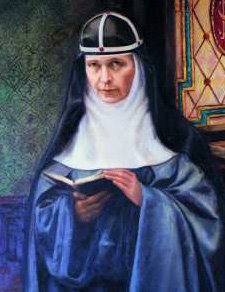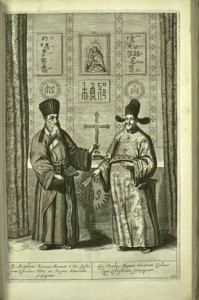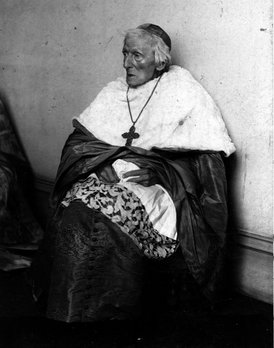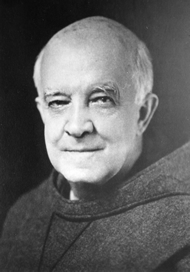 Among the decrees promulgated by Archbishop Angelo Amato, SDB, Prefect of the Congregation for Saints, is the recognition of heroic virtue of the Servant of God Maria Kaupas (in history Casimira Kaupas). She founded the Congregation of Sisters of Saint Casimir, in Scranton, PA, on August 29, 1907.
Among the decrees promulgated by Archbishop Angelo Amato, SDB, Prefect of the Congregation for Saints, is the recognition of heroic virtue of the Servant of God Maria Kaupas (in history Casimira Kaupas). She founded the Congregation of Sisters of Saint Casimir, in Scranton, PA, on August 29, 1907.
Category: Sainthood causes
Bernard J. Quinn: Another possible saint from NY?
Read Paul Vitello’s NY Times article for today for more (even with several notable errors & omissions)….
Blessed Mother Maria Elizabeth Hesselblad: 10th anniversary
 Today is the 10th anniversary of the beatification of Mother Maria Elizabeth Hesselblad, the woman who re-established the Swedish branch of the Order of the Most Holy Savior of Saint Bridget —Bridgettine Order after centuries of the charism’s absence, in 1911. This is the order of nuns founded by Saint Bridget (Birgitta) of Sweden (1303-1373).
Today is the 10th anniversary of the beatification of Mother Maria Elizabeth Hesselblad, the woman who re-established the Swedish branch of the Order of the Most Holy Savior of Saint Bridget —Bridgettine Order after centuries of the charism’s absence, in 1911. This is the order of nuns founded by Saint Bridget (Birgitta) of Sweden (1303-1373).
Saint Bridget of Sweden, not to be confused with the Irish saint, was named co-paroness of Europe on October 1, 1999.
Today the order numbers some 700 sisters in 50 houses around the world. In the USA, there is one house of Bridgettine nuns, in Darien, Connecticut, in the Diocese of Bridgeport. The order has about a 4% growth per annum with about 30 novices entering yearly. Info on Wiki can be read here.
There is a group of Bridgetine monks in Oregon, themselves re-founded in 1976.
Blessed Maria Elizabeth Hesselblad’s liturgical memorial is June 4.
Oscar A. Romero: 30 years since his assassination
Today is the 30th anniversary of the assassination of Oscar A. Romero, Archbishop of San Salvador, in El Salvador. He was murdered while celebrating Mass at a cancer hospital where he lived. Finishing the homily, a group of military death squad shot Romero.
John Henry Newman to be beatified by Benedict XVI
It was announced this morning by the Holy See that Pope
Benedict XVI will beatify John Henry Newman on 19th September 2010, during his
visit to the U.K., in the Archdiocese of Birmingham. The Cause of Newman’s
Canonisation has released the following statement:
The Fathers and many friends
of the English Oratories are delighted by the official announcement that our
Holy Father Pope Benedict XVI will beatify our founder, the Venerable John Henry
Newman, in the Archdiocese of Birmingham during his visit to Britain in
September. Newman made his home in the Archdiocese for all his adult life,
first in Oxford, where he lived as an Anglican and was received into the
Catholic Church, and later in Birmingham itself where he founded and worked in
the Birmingham Oratory for over forty years.
The Holy Father’s life-long
devotion to Newman has made a profound contribution to understanding the depth
and significance of our founder’s legacy. His decision to beatify Newman in
person confers a unique blessing upon the English Oratories and all who have
drawn inspiration from Newman’s life and work.
We joyfully look forward to
welcoming the Holy Father, as well as the many pilgrims and visitors who will
come to the Beatification ceremony and visit Newman’s shrine at the Birmingham
Oratory.
We also look forward to the challenging work of preparing for the
Beatification in conjunction with Church and civil authorities. We pray that
the Beatification will fittingly reflect both Newman’s significance for the
Universal Church and the honour paid to our Archdiocese and our country by the
Holy Father’s presence among us.
Very Rev. Richard Duffield
Provost of the Birmingham Oratory and Actor of the Cause of
John Henry Newman
Additionally, the Procurator of the Congregation of the Oratory, Very Reverend Father Edoardo Aldo Cerrato, CO, has written to the all the Oratories of the world on this great gesture of Pope Benedict XVI in personally beatifying the Venerable Servant of God John Henry Newman. The letter is here: Letter-of-the-Procurator-General-of-the-Oratory-Confederation-March-2010.pdf
Matteo Ricci on tract for sainthood?
 This is old news by now, but the Agenzia Fides reported back in late January that the cause for canonization for Father Matteo Ricci is again active. Ricci always held a special place in my imagination partly because he was (and continues to be) maligned by ideologues. I noted Ricci’s 400th anniversary on this blog back in May.
This is old news by now, but the Agenzia Fides reported back in late January that the cause for canonization for Father Matteo Ricci is again active. Ricci always held a special place in my imagination partly because he was (and continues to be) maligned by ideologues. I noted Ricci’s 400th anniversary on this blog back in May.
The sainthood cause for 16th-century Jesuit missionary Matteo Ricci was reopened on January 24, following Mass at the Cathedral of San Giuliano in the diocese of Diocese of Macerata-Tolentino-Recanati-Cingoli-Treia, where he was born.
The process of beatification originally launched in 1984 when he was named a Servant of God. Bishop Claudio Giuliodori of Macerata said that although the cause stalled soon after it was opened, “these 25 years have not passed in vain because the Lord has given us clear signs of a deeper understanding of the prophetic intuitions of Father Matteo Ricci.”
Father Matteo Ricci was born in 1552 in the Marche town of Macerata. He entered the Society of Jesus and was missioned by his superiors to study mathematics and astronomy before leaving for the Far East at the age of 26.
Ricci’s itinerary included four years in Goa (west coast of India) before traveling to China. On mainland China he settled in Zhao Qing in the southernmost Guangdong Province; he was proficient in studying Chinese. During his time there he produced his global “Great Map of Ten Thousand Countries,” which revolutionized the Chinese understanding of the rest of the world. A copy of the map is on display at the United States Library of Congress.
In 1589 Father Ricci moved to Zhao Zhou and began sharing European mathematical discoveries with Chinese scholars. He became known as “Li Madou” and was renowned for his extraordinary memory and knowledge of astronomy. He eventually became a member of the court of Ming Emperor Wanli.
In 1601 he was allowed into the Forbidden City of Beijing, where he worked until his death in 1610.
Ricci’s postulator (the person promoting the inquiry for the sainthood) is Jesuit Father Anthony Witwer, who is coordinating and supervising a historical commission that has been established to collect all the writings and documents attributed to Father Ricci, along with those that reference him in publication. The commission’s work will conclude with a critical study on the writings of Matteo Ricci along with a judgment as to the authenticity and value of documents on him.
In a message to the Diocese of Macerata inaugurating commemorations of the 400th anniversary of Father Ricci’s death in Beijing in 1610, Pope Benedict XVI wrote that Father Ricci was “gifted with profound faith and extraordinary cultural and academic genius.” He “dedicated long years of his life to weaving a profound dialogue between West and East, at the same time working incisively to root the Gospel in the culture of the great people of China. Even today, his example remains as a model of fruitful encounter between European and Chinese civilization. In considering his intense academic and spiritual activity, we cannot but remain favorably impressed by the innovative and unusual skill with which he, with full respect, approached Chinese cultural and spiritual traditions. It was, in fact, this approach that characterized his mission, which aimed to seek possible harmony between the noble and millennial Chinese civilization and the novelty of Christianity, which is for all societies a ferment of liberation and of true renewal from within, because the Gospel, universal message of salvation, is destined for all men and women whatever the cultural and religious context to which they belong.”
The Pope continued, “What made his apostolate original and, we could say, prophetic, was the profound sympathy he nourished for the Chinese, for their cultures and religious traditions.” Ricci was likewise “a model of dialogue and respect for the beliefs of others and made friendship the style of his apostolate during his twenty-eight years in China.”
History shows us that Ricci remained faithful to this style of evangelization to the end of his life. He made the gospel accessible to people, especially the intellectual classes by “using a scientific methodology and a pastoral strategy based, on the one hand, on respect for the wholesome customs of the place, which Chinese neophytes did not have to abandon when they embraced the Christian faith and, on the other, on his awareness that the Revelation could enhance and complete” those customs. As the Fathers of the Church did in the time of the encounter between the Gospel and Greco-Roman culture, the author of the “Treatise on Friendship” undertook his “farsighted work of inculturation of Christianity in China by seeking constant understanding with the wise men of that country.”
The concluded his anniversary remarks by saying that we, “Following his example, may our own communities, which accommodate people from different cultures and religions, grow in a spirit of acceptance and of reciprocal respect.”
Anthony E. Clark’s article “Weaving a Profound Dialogue between West and East”: On Matteo Ricci, S.J., for Ignatius Insight is helpful for a much broader perspective. Plus, Scranton University hosts a blog entry on Father Ricci that shows a bit his depth of character that you may find interesting.
Paul Wattson: RIP 70 years
Some words by Father Paul Wattson
up and kindle within us, is the gift of our Lord himself to us in the Blessed
Sacrament. That is the very heart and center of the religious life. It is our
exceedingly great privilege to
have come out of the world and assemble ourselves in the religious houses,
where we practically live under the same roof with our heavenly bridegroom.
a most intimate manner we receive Him every morning in Holy Communion. When we
receive our Lord in Holy Communion, we receive God’s body, blood, soul and divinity,
the whole Christ, entering our lips and penetrating the inmost recesses of our heart
even as he said, “He that eats my flesh and drinks my blood, abides in me
and I in him.” [John 6:56] Consequently our life is a life of most intimate
union. Our divine Savior would not only have us live under the same roof with
him and dwell in our chapels, which are for the time being a part of the court
of Heaven, but he enters into our interior and penetrates our whole being and
lives in us in this wonderful union. And all this is the fruit and the result
of the Blessed Sacrament. Therefore, we should have a most wonderful devotion
to the Holy Eucharist. (Father Paul Wattson, SA, Retreat Conference August 19, 1926)
remembrance of Father Paul Wattson from a 2009 Communio
blog entry.
John Paul was prepared to resign papacy, focused on his spiritual life
 The postulator (main promoter/researcher) of the cause of canonization of the Servant of God Pope John Paul II, Msgr. Slawomir Oder, published the full text of John Paul II’s resignation letter in his recent book, Why He Is Holy (only in Italian at the moment).
The postulator (main promoter/researcher) of the cause of canonization of the Servant of God Pope John Paul II, Msgr. Slawomir Oder, published the full text of John Paul II’s resignation letter in his recent book, Why He Is Holy (only in Italian at the moment).
Venerable Servant of God Pierre Toussaint, pray for Haiti (and for us here)
 The tragedy in Haiti brings to mind the presence of the Venerable Servant of God Pierre Toussaint entombed in Saint Patrick’s Cathedral, a native of Haiti and whose cause is being studied for beatification and canonization.
The tragedy in Haiti brings to mind the presence of the Venerable Servant of God Pierre Toussaint entombed in Saint Patrick’s Cathedral, a native of Haiti and whose cause is being studied for beatification and canonization.
Pius and Jewish opinion
Members of The World Jewish Congress, among others, have made their opinions about Pope Benedict’s acknowledgement of his predecessor’s heroic virtues, step two of four with the goal of being recognized a saint. Pope Pius XII was head of the Catholic Church (1939-58) during the Second World War and falling asleep in the Lord in 1958. The WJC thinks Benedict was wrong in moving Pius closer to sainthood. BTW, a pope does not have the power to make saints because he doesn’t have absolute power; that would make him more powerful than God. For the record, God makes saints, the church’s process recognizes what God has done.



